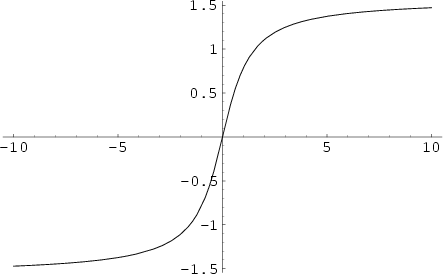The inverse tangent is also called the arctangent and is denoted either  or arctan
or arctan  . It has the
Maclaurin Series
. It has the
Maclaurin Series
 |
(1) |
A more rapidly converging form due to Euler  is given by
is given by
 |
(2) |
(Castellanos 1988). The inverse tangent satisfies
 |
(3) |
for Positive and Negative  , and
, and
 |
(4) |
for  . The inverse tangent is given in terms of other inverse trigonometric functions by
. The inverse tangent is given in terms of other inverse trigonometric functions by
for Positive or Negative  , and
, and
for  .
.
In terms of the Hypergeometric Function,
(Castellanos 1988). Castellanos (1986, 1988) also gives some curious formulas in terms of the Fibonacci Numbers,
where
and  is the largest Positive Root of
is the largest Positive Root of
 |
(19) |
The inverse tangent satisfies the addition Formula
 |
(20) |
as well as the more complicated Formulas
 |
(21) |
 |
(22) |
 |
(23) |
the latter of which was known to Euler.  The inverse tangent Formulas are
connected with many interesting approximations to Pi
The inverse tangent Formulas are
connected with many interesting approximations to Pi
 |
(24) |
Euler  gave
gave
 |
(25) |
where
 |
(26) |
The inverse tangent has Continued Fraction representations
 |
(27) |
To find  numerically, the following Arithmetic-Geometric Mean-like Algorithm can
be used. Let
numerically, the following Arithmetic-Geometric Mean-like Algorithm can
be used. Let
Then compute
and the inverse tangent is given by
 |
(32) |
(Acton 1990).
An inverse tangent  with integral
with integral  is called reducible if it is expressible as a finite sum of the form
is called reducible if it is expressible as a finite sum of the form
 |
(33) |
where  are Positive or Negative Integers and
are Positive or Negative Integers and  are Integers
are Integers  .
.
 is reducible Iff all the Prime factors of
is reducible Iff all the Prime factors of  occur among the Prime factors of
occur among the Prime factors of  for
for  , ...,
, ...,  . A second Necessary and Sufficient condition is that the largest Prime factor
of
. A second Necessary and Sufficient condition is that the largest Prime factor
of  is less than
is less than  . Equivalent to the second condition is the statement that every Gregory Number
. Equivalent to the second condition is the statement that every Gregory Number
 can be uniquely expressed as a sum in terms of
can be uniquely expressed as a sum in terms of  s for which
s for which  is a Størmer
Number (Conway and Guy 1996). To find this decomposition, write
is a Størmer
Number (Conway and Guy 1996). To find this decomposition, write
 |
(34) |
so the ratio
 |
(35) |
is a Rational Number. Equation (35) can also be written
 |
(36) |
Writing (33) in the form
 |
(37) |
allows a direct conversion to a corresponding Inverse Cotangent Formula
 |
(38) |
where
 |
(39) |
Todd (1949) gives a table of decompositions of  for
for  . Conway and Guy (1996) give a similar table in
terms of Størmer Numbers.
. Conway and Guy (1996) give a similar table in
terms of Størmer Numbers.
Arndt and Gosper give the remarkable inverse tangent identity
![\begin{displaymath}
\sin\left({\sum_{k=1}^{2n+1} \tan^{-1} a_k}\right)= {(-1)^n\...
...1}\right)}\right]\over \sqrt{\prod_{j=1}^{2n+1} ({a_j}^2+1)}}.
\end{displaymath}](i_1071.gif) |
(40) |
See also Inverse Cotangent, Tangent
References
Abramowitz, M. and Stegun, C. A. (Eds.). ``Inverse Circular Functions.'' §4.4 in
Handbook of Mathematical Functions with Formulas, Graphs, and Mathematical Tables, 9th printing.
New York: Dover, pp. 79-83, 1972.
Acton, F. S. ``The Arctangent.'' In Numerical Methods that Work, upd. and rev. Washington, DC:
Math. Assoc. Amer., pp. 6-10, 1990.
Arndt, J. ``Completely Useless Formulas.''
http://www.jjj.de/hfloat/hfloatpage.html#formulas.
Beeler, M.; Gosper, R. W.; and Schroeppel, R. HAKMEM. Cambridge, MA: MIT
Artificial Intelligence Laboratory, Memo AIM-239, Item 137, Feb. 1972.
Beyer, W. H. CRC Standard Mathematical Tables, 28th ed. Boca Raton, FL: CRC Press, pp. 142-143, 1987.
Castellanos, D. ``Rapidly Converging Expansions with Fibonacci Coefficients.'' Fib. Quart. 24, 70-82, 1986.
Castellanos, D. ``The Ubiquitous Pi. Part I.'' Math. Mag. 61, 67-98, 1988.
Conway, J. H. and Guy, R. K. ``Størmer's Numbers.'' The Book of Numbers. New York: Springer-Verlag, pp. 245-248, 1996.
Todd, J. ``A Problem on Arc Tangent Relations.'' Amer. Math. Monthly 56, 517-528, 1949.
© 1996-9 Eric W. Weisstein
1999-05-26


![]() or arctan
or arctan ![]() . It has the
Maclaurin Series
. It has the
Maclaurin Series














![]() with integral
with integral ![]() is called reducible if it is expressible as a finite sum of the form
is called reducible if it is expressible as a finite sum of the form
![\begin{displaymath}
\sin\left({\sum_{k=1}^{2n+1} \tan^{-1} a_k}\right)= {(-1)^n\...
...1}\right)}\right]\over \sqrt{\prod_{j=1}^{2n+1} ({a_j}^2+1)}}.
\end{displaymath}](i_1071.gif)